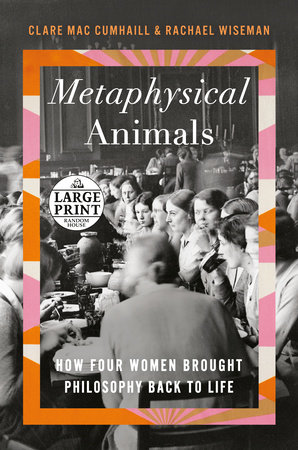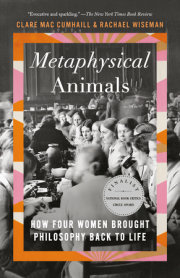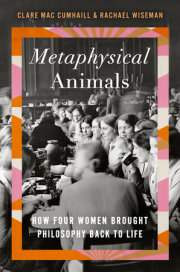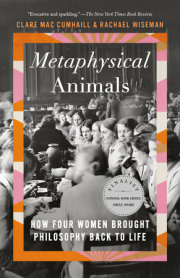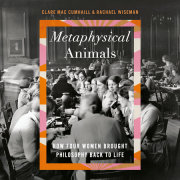CHAPTER 1
On Probation
Oxford
October 1938–September 1939
Miss Mary Scrutton & Miss Iris Murdoch of Somerville College
Early in her schooldays Mary Scrutton had an experience of seeing pure sense data. It happened like this. ‘I was bending over a bath, stirring the water before getting into it, when I felt a light tap on the back of my head and the world before me suddenly turned into an expanse of white triangles.’ As she looked in wonder, the triangles began to move and turn blue at the edges. Finally, things began to reassemble. The white patches were not tiny sensory objects, fragments of private experience, but small pieces of the plaster ceiling, gently shattering as they tapped her on the head on their downward flight into the bath. Later, when she started studying philosophy, she remembered this scene, in which she had experienced pure colour and shape. Is it possible that the stable world of baths and ceilings can be assembled out of such ephemeral fragments? she wondered. Are baths and ceilings no more than constellations of appearances? Mary was thinking thoughts that had troubled the mind of the ancient philosopher Protagoras, on an island in the Aegean Sea, 450 years before the birth of Christ.
Now, in the mild, breezy autumn of 1938, she was on Oxford’s busy Woodstock Road, facing the arched entrance of Somerville College, her back to the low morning sun and a pair of perfectly circular glasses perched high on her nose. As she stepped through, her childhood folded silently behind her: the garden walls of her girlhood home, a rectory in Greenford in Middlesex with its chestnut and ilex trees; her teenage bedroom, book-strewn, in the new house in Kingston-upon-Thames; herself and her mother, Lesley, smiling in matching chinoiserie dresses; an impractically shaped dachshund singing by the gramophone; her father’s car, the starting-handle of which was kept not by the bonnet but by the driver’s seat so he didn’t have to run around to the side in the rain before leaping in when the engine started. Her hair may have been temporarily in an adult roll, but more often it was braided like a Girl Guide’s. As a child, she preferred collecting newts to dolls, whose stiff perms when replicated in living women unnerved her. She vigorously resisted her mother’s attempts to put her hair in a Marcel wave – ‘it’s far too stiff. I don’t believe in it.’ At nearly six foot, she could not see a way to be ‘dainty’. Her shoelaces were often undone, broken or replaced with string. She was more likely to find a fountain pen leaking in her pocket than a glove or compact, or anything betokening a grown-up female life. Mary took some pride in her ability – which she retained – to be vaguely exasperating to her peers and elders. A letter from her father pointed the way forward: ‘The great thing is, to clear one’s mind and REFUSE TO ACCEPT OUTWORN PRESUPPOSITIONS. Form a picture of mankind as it should be and think out the path to that state.’
By the time Mary stood at Somerville Lodge, Prime Minister Neville Chamberlain had declared ‘peace for our time’; but trenches were already being dug in London parks. Most could see that Europe was now heading inexorably towards a second war. Many of the young men who found themselves, as Mary did, at the gates of Oxford colleges and on the threshold of adulthood, did not expect to finish their degrees.
If things had gone to plan, Mary would have arrived at Somerville fresh from Vienna, her German fluent, her conversation studded with casual references to Viennese culture and art. But her Austrian adventure had been cut short: she had arrived in the capital a fortnight before the country ceased to exist. Mary’s teacher, Jean Rowntree (granddaughter of the Quaker philanthropist, Joseph Rowntree), had reassured her concerned parents that it would be safe and that any dangers posed by fascism would be balanced by improvements in Mary’s German. Jean had spent a sabbatical term in Vienna in 1935, working alongside other Quakers to assist fleeing civilians, and was shortly off to Prague to do the same there, so she knew more than most about the situation in Europe. But on 12 March, Mary watched from the window as Nazis marched through the city, lacing the Ringstrasse lamp posts with swastikas sewn on to billowing red banners. Blonde German girls handed out flowers and beamed as Jewish shops were ransacked and their owners rounded up. Professor Jerusalem, Mary’s Jewish host, was among those arrested, and Mary picked her way through the broken glass on the pavement to join a frantic queue at the Quaker meeting house, hoping the Society of Friends could help. They couldn’t – Professor Jerusalem was an Austrian citizen – and she cried all the way through the interview.
Mary returned to England before the month was out, and her hosts were, thankfully, not far behind her. On Professor Jerusalem’s release, he, Frau Jerusalem and their fourteen-year-old daughter Leni managed to escape Austria to join Mary and her family at their home. They would stay with the Scruttons until the following April, when they received permits for a new life in Palestine.
Mary had been offered the Deakin Scholarship (£50 per year, for three years) after a panicked attempt at an entrance exam in Autumn 1937, from which she expected nothing but disaster. She was a product of Downe House, a school that had begun life in Charles Darwin’s home before moving to The Cloisters, the former home of a female religious community in Berkshire. The school’s founder and headmistress, Olive Willis, took inspiration from the American pragmatist philosopher John Dewey. The fundamental task for an educator was to curate her pupils’ experiences, cultivating impressions that will ‘live fruitfully and creatively in subsequent experiences’. As the child grows, ‘life-space and life-durations are expanded’, he explained, and a school must lay down a store of experiences that will allow her to navigate this expanding future with well-tempered curiosity. Olive Willis fostered non-autocratic relationships between teacher and student. Young and old were to be real friends. Reform would be gentle. Mary had been excited at her election to Form Captain, until she discovered it was part of the ‘Tidier Scrutton Campaign’, launched after the loss of a bicycle, music case, three screw-pencils, a badminton racket and the Book of Judges roused her classmates to action. At Downe there were no prizes, no Head Girl and no houses. Tests and competitions were not part of Mary’s childhood. But despite her misgivings about the Somerville examination, her General Paper had impressed.
At the request of the college, Mary had spent the year before going up having coaching in Latin and Greek from Mrs Zvegintzov (formerly Miss Diana Lucas), a tall masterful ex-Somervillian, married to the son of Russian émigrés, to whom the college regularly referred prospective students. Mrs Z’s methods were severe and surprising. Prudence Smith, another Somervillian sent to Mrs Z, complained to her boyfriend: ‘she suggests in all sobriety that I lie in a cold bath . . . and sing the declensions and conjugations’. Despite Prue’s scepticism, the unusual method proved so successful that she feared that in her dying moments she would find Goodwin’s ‘Greek Moods and Tenses’ marching through her head. Mrs Z was astounded by Mary’s ignorance – but also by her success. ‘Well, well,’ she said, on hearing of Mary’s scholarship to Somerville, ‘I’d rather lose my reputation as a prophet than my reputation as a coach.’
Mrs Z had another tutee that year, on whom she might well have risked a forecast, Miss Iris Murdoch. Iris was once said to be a ‘poor girl who only just made it into a rich girls’ school’. The only daughter of Irish Protestant immigrants, Iris was born on 15 July 1919 at 59 Blessington Street, Dublin – a down-at-heel Georgian terrace on the north side of the River Liffey. The family had crossed the Irish Sea to settle in London later that year; part of a mass upheaval of people around the time of the partition of Ireland in 1921. Iris said her father had come to England to find his fortune, but her parents did not assimilate, making few, or maybe no, friends in suburban west London. When Hughes Murdoch died after forty-five years in England, there were only six people at his funeral.
In 1932, twelve-year-old Iris had won one of the first two available open scholarships to Badminton, an exclusive girls’ school in the suburbs of Bristol. Miss Colebrook, the school secretary, wrote to Iris’s delighted parents that her scholarship had been announced in The Times, the Manchester Guardian and the local newspapers: ‘It looks very well’. Badminton’s principal, Miss Beatrice May Baker (alias BMB), was a progressive woman with an international outlook – pupils between the wars were told: ‘You must not expect jam for tea while German children are starving’. When Iris had first arrived at the school, she suffered from terrible homesickness. She cried so much during her first weeks that one of the older pupils formed the Society for the Prevention of Cruelty to Iris (SPCI), the sole activity of which was being nice to her. BMB sent Iris to ‘work in the garden under the care of the lady head gardener’, in the hope that the ‘less stimulating’ atmosphere would calm her. The young Iris could be found in the greenhouse, dressed in the fawn-coloured tunic and woollen blouse that was the school’s uniform, ‘pricking out seedlings . . . quietly and painstakingly’.
The combined efforts of BMB and the SPCI paid off and Iris soon ‘stopped crying and started to write colourful, imaginative and brilliant essays’, a classmate recalled. As Iris progressed through the school, BMB made her a favourite and the odd pair would be seen in BMB’s drawing room deep in philosophical conversation. Younger girls remembered Iris as a good hockey player and a well-liked head prefect who everyone knew ‘was very clever’. ‘Iris was a remarkable girl, who already had a philosophy of life’, BMB told the girls in the year below. Iris ‘was one of the kindest people that I have ever met’, recalled her Latin teacher, Miss Jeffery. In 1938 she was awarded an Open Exhibition of £40 a year by Somerville College.
Mary may have dodged past Iris in Mrs Z’s hallway that summer, belongings and shoelaces trailing, head buzzing with Greek declensions. But it was only once inside the walls of Somerville College that the pair met properly. With a blunt fringe and dirndl-ish clothes, Iris was now artsy, assured and immediately at ease in her new habitat and role – there was no repeat of her Badminton homesickness. Though Mary was by far the taller, when people saw her and Iris together, crossing the Somerville College lawn, it was Iris they remembered – her ‘corn-hair’ and confidence caught the eye. ‘She’s like a little bull!’ observed a friend’s mother. Fellow undergraduate Carol Stewart thought Iris ‘aboriginal’: ‘simplicity, naiveté, power, and space’. In that year’s matriculation photo, Mary, wearing a dark woollen suit, sits awkwardly on the front row (fourth from left); Iris, in a light cotton blouse, stands behind (second row, fourth from right).
There were forty-three Somerville entrants that year and, Mrs Z’s astonishment notwithstanding, Iris and Mary were the only two up to read Honour Moderations and Literae Humaniores. More commonly known as ‘Mods and Greats’, the four-year degree had two parts. ‘Mods’ would last five terms and culminate in twelve three-hour examinations across seven consecutive days. Candidates would be required to translate unseen passages of Greek and Latin poetry and prose with seamless facility. Success would see them progress to seven terms of ‘Greats’, which took in Greek and Roman history, archaeology and art, as well as philosophy. They would tackle a little modern philosophy up to and beyond Kant (including Hegel and Marx), as well as some logic, ethics and political philosophy. But the largest part of their studies would be devoted to Ancient Philosophy, along with its reception in Christian thought in the Middle Ages. Plato’s Republic and Aristotle’s Nicomachean Ethics, which they would read in Greek, would be their main diet. In their first year of Greats, Iris and Mary would have the pick of fourteen lecture courses dedicated to works over 2,000 years old.
All this was ahead of them as Mary sat cross-legged on Iris’s floor that first term, Iris lying on her bed surrounded by books and flowers, penning an enthusiastic letter to a schoolfriend. She was delighted that the dons called her ‘Miss Murdoch’; at school she’d been only ‘Iris’. The change of name signified a change of state. Iris had a sunny room in East, Somerville’s new front quadrangle, while Mary’s was dark and at the other end of the oldest building, West. Anyone who had any money went out at once to buy a comfortable chair for their room, and from Iris’s first-floor window, above the archway overlooking the small front quad, a parade of armchairs could be seen crossing the lawn, moving in and out of doorways, as the new undergraduates settled in. Iris settled instead for a striped aquamarine art deco cushion.
Iris and Mary, along with the other new arrivals – fledgling zoologists, linguists, mathematicians and historians – were soon summoned to the Junior Common Room by Somerville’s French tutor, Vera Farnell. Speaking as Dean, she warned that any misstep, any rule-breaking or scandal, would injure not only themselves but future generations of aspirant women scholars. She told them sternly: ‘You must seriously realise that you have to be careful how you behave. It isn’t a joking-matter, the women are still very much on probation in this University. You may think that it doesn’t matter if you do something a little wild, but I can tell you that it will.’ Within months, she had her eyes trained on Miss Scrutton’s academic dress (the clothing worn under the scholar’s long black gown).
Mary found a caution in her pigeonhole.
Miss Scrutton was not the first undergraduate to receive sartorial correction from Miss Farnell. As an undergraduate Vera had conveyed a message from the then Principal Emily Penrose to fellow undergraduate (and future novelist) Dorothy Sayers: earrings featuring ‘scarlet and green parrots in pendent gilt cages’ amounted to ‘unnecessarily, even outrageously, conspicuous behaviour and attire’.
Vera Farnell spoke from experience when she issued her warning. She had arrived at Somerville to read modern languages in 1911, almost a decade before women were permitted to take degrees. The fight had been hard won and many in the wider community, including many women, remained unconvinced. Who could tell what new forms of female life were taking shape within the walls of the women’s colleges, and what the effect might be on the world outside?
Copyright © 2022 by Clare Mac Cumhaill. All rights reserved. No part of this excerpt may be reproduced or reprinted without permission in writing from the publisher.

